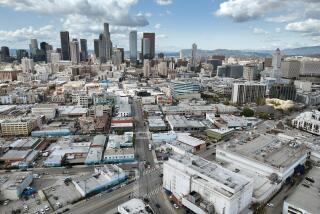The Sky’s No Limit for Malaysia’s Building Jag
- Share via
KUALA LUMPUR, Malaysia — Having pierced the sky with the world’s tallest building, Malaysians are casting their eyes downward. They’re ready to erect the world’s longest building.
Fueled by a booming oil and manufacturing economy, this Southeast Asian nation isn’t slowing down its building binge to savor bragging rights.
Workers topped out the twin Petronas Towers at 1,483 feet in February, making the Malaysian oil monopoly’s headquarters 33 feet higher than the previous record holder, the Sears Tower in Chicago. But the title may be gone soon--China is planning a 1,509-foot building for Shanghai.
Nobody seems concerned in Malaysia. Attention is now focused on the architectural extravaganza of “Linear City.”
Budgeted at $4 billion, the 10-story tube-like structure on stilts is supposed to snake for 1 1/4 miles above the Klang River that winds through downtown Kuala Lumpur.
The centerpiece of the structure is “Giga World,” so named by its backers as a step above “mega.” The open-sided building is to have a canal running through the seventh floor, an artificial rain forest, shops, restaurants, offices and even an in-line skating area.
The entrepreneurs behind Linear City hope to begin the first phase--a 5-mile monorail through the heart of the capital--by September.
*
Officials say Prime Minister Mahathir Mohamad supports the project and wants it ready by September 1998, when Malaysia plays host to the Commonwealth Games, an athletic competition for Britain and its former colonies.
Not everyone is happy.
Environmental activists point out that a study commissioned by the project’s promoters says air and water pollution could worsen during construction along the 100-foot-wide Klang.
The study also says those problems should not be serious enough to block the project, and the developers promise they will upgrade and landscape the river, which has become little more than an open sewer.
Opposition politicians complain that the privately financed project was not put out to public bid. All construction would be on public land allocated under a 99-year lease.
Linear City joins a building spree of mega-projects designed to put Malaysia on the world map as part of Mahathir’s “Vision 20-20,” a drive to have his country fully developed by 2020.
In power since 1981, Mahathir has transformed a rural economy based on rubber, palm oil and tin into a manufacturing center averaging 8% annual growth over the last nine years.
The boom has not been trouble-free. There are not enough workers, particularly skilled ones. Inflation is rising and imports are increasingly outstripping exports.
The government concedes Malaysia must increase its exports to staunch a growing balance of payments deficit. It is trying to restrain domestic consumption by raising interest rates, boosting down payments needed to buy houses and cars on credit and getting banks to increase their reserves to reduce the money supply.
Meantime, Mahathir spurns those who criticize the colossal infrastructure projects as grandiose monuments.
“They only look like monuments, even though they are not monuments to us,” he said earlier this year in defending the Petronas Towers and plans for a new capital city.
*
He shows no patience with the worries of environmentalists when a pet project is involved.
“Malaysia wants to develop and I say to the so-called environmentalists: ‘Mind your own business,’ ” he said during a visit to the Bakun hydroelectric project in Sarawak state on the island of Borneo.
Among the other big projects:
* Bakun Dam, to be built on the upper reaches of Sarawak’s Rejang River, will flood an area the size of Chicago and is expected to be second in size only to China’s Three Gorges Dam when completed by 2003. It will clear more than 165,000 acres of tropical rain forest and displace 9,000 tribes people. Bakun faces a court challenge from Sarawak natives.
* Putrajaya, a new $8-billion “garden city” to replace Kuala Lumpur as the capital. Sixteen miles south of Kuala Lumpur, it’s deemed necessary because government offices are scattered all over increasingly congested Kuala Lumpur and its suburbs. Mahathir broke ground for Putrajaya a year ago and the target date for completion is 2005.
* A $3.5-billion international airport at Sepang is supposed to begin commercial operations in 1998 with a capacity of 25 million passengers a year in the first phase.
* Bukit Jalil, a tract of land near Kuala Lumpur, will be home to Malaysia’s Commonwealth Games complex. Total spending plans top $470 million in what Malaysia hopes will be the most extravagant tournament so far.
* A five-year development plan that includes $19.4 billion for 9,942 miles of new roads.
In the talking stage is a plan to replace the road-rail causeway link to Singapore with a high bridge that would allow seagoing ships to use the Straits of Johore.
Also under consideration is an oil pipeline across the Malaysia-Thailand isthmus. That would give shippers an alternative to sailing around the Malay Peninsula through the busy Malacca Straits, cutting 620 miles off the sea transport distance between the Middle East and the Far East.
More to Read
Sign up for Essential California
The most important California stories and recommendations in your inbox every morning.
You may occasionally receive promotional content from the Los Angeles Times.










